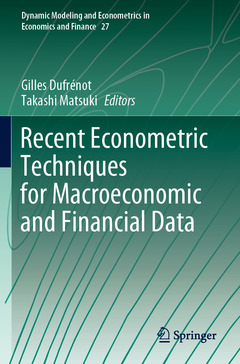Recent Econometric Techniques for Macroeconomic and Financial Data, 1st ed. 2021 Dynamic Modeling and Econometrics in Economics and Finance Series, Vol. 27
Coordonnateurs : Dufrénot Gilles, Matsuki Takashi

The book provides a comprehensive overview of the latest econometric methods for studying the dynamics of macroeconomic and financial time series. It examines alternative methodological approaches and concepts, including quantile spectra and co-spectra, and explores topics such as non-linear and non-stationary behavior, stochastic volatility models, and the econometrics of commodity markets and globalization. Furthermore, it demonstrates the application of recent techniques in various fields: in the frequency domain, in the analysis of persistent dynamics, in the estimation of state space models and new classes of volatility models.
The book is divided into two parts: The first part applies econometrics to the field of macroeconomics, discussing trend/cycle decomposition, growth analysis, monetary policy and international trade. The second part applies econometrics to a wide range of topics in financial economics, including price dynamics in equity, commodity and foreign exchange markets and portfolio analysis. The book is essential reading for scholars, students, and practitioners in government and financial institutions interested in applying recent econometric time series methods to financial and economic data.
Gilles Dufrénot is a Professor of Economics at Aix-Marseille School of Economics in France. His main fields of interest are applied econometrics in macroeconomics and finance. He has published in international journals including the Journal of Economic dynamics and Control, Macroeconomic Dynamics, Journal of International Money and finance, Oxford Economic Papers. He has been a guest editor for several journals on issues related to nonlinear dynamics, macroeconometrics and computational economics.
Takeshi Matsuki is a Professor of Econometrics and Statistics at the University of Osaka-Gakuin in Japan. He specializes in forecasting methods, nonlinear systems and nonstationary panels in economics and finance. He has proposed new techniques for investigating international spillovers in international markets, channeling quantitative easing policies and identifying structural breaks in economic time series.
Applies econometric methods to a wide range of issues in macroeconomics and financial economics
Offers new tools for studying non-linear and non-stationary behaviors
Explores topics such as non-linear and non-stationary behavior, stochastic volatility models, and the econometrics of commodity markets and globalization
Date de parution : 11-2021
Ouvrage de 387 p.
15.5x23.5 cm
Date de parution : 11-2020
Ouvrage de 387 p.
15.5x23.5 cm



